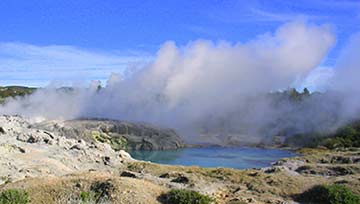| About Geothermal Energy |
The interior of the Earth is expected to remain extremely hot for billions of year to come, ensuring an essentially limitless flow of heat. Geothermal power plants capture this heat
and convert it to energy in the form of electricity.
Many people think Geothermal Energy is Experimental and Not Yet Widely Used. The truth is; Geothermal resources have been in use in the United States for more than 10,000 years, according to archaeological evidence. The Paleo-Indians first used geothermal hot springs for warmth, cleansing, and minerals through direct use.
|
|
The first large-scale geothermal electricity-generating plant opened at Larderello, Italy in 1904, and continues to operate successfully. The first commercial U.S. geothermal power plant producing power to the utility grid opened at The Geysers in California in 1960, producing 11 megawatts of net power. The Geysers system continues to operate successfully today, and represents the largest single sources of renewable energy in the world. The United States has nearly 2800 megawatts of electricity connected to the grid.
As the world’s largest producer of geothermal energy, The U.S. generates a yearly average of 15 billion kilowatt hours of power, comparable to burning about 25 million barrels of oil or 6 million short tons of coal per year. Geothermal energy is used for electrical power production in 21 countries, and supplies significant amounts of electricity to countries such as the Philippines, where 27 percent of electricity derives from geothermal sources. Even so, this worldwide use represents only a fraction of the potential power that could be generated from geothermal resources. As technology continues to advance, the expected cost and risk of using geothermal resources will continue to decline while the geothermal contribution to our energy needs will continue to expand. |
What is an Enhanced Geothermal System (EGS)?
A naturally occurring geothermal system, known as a hydrothermal system, is defined by three key elements: heat, fluid, and permeability at depth. An Enhanced Geothermal System (EGS) is a man-made reservoir, created where there is hot rock but insufficient or little natural permeability or fluid saturation. In an EGS, fluid is injected into the subsurface under carefully controlled conditions, which cause pre-existing fractures to re-open, creating permeability. Increased permeability allows fluid to circulate throughout the now-fractured rock and to transport heat to the surface where electricity can be generated. While advanced EGS technologies are young and still under development, EGS has been successfully realized on a pilot scale in Europe and now at two DOE-funded demonstration projects in the United States. The Geysers field in northern California boasts the largest geothermal complex in the world and the first successful demonstration of EGS technologies in the United States
|
 |
| Back to Geothermal Energy |
|